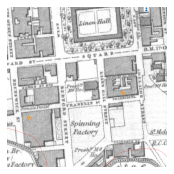28 Bedford Street: A History

|
At the beginning of the 19th century, linen production across Ireland was largely domestic in nature. However, with advances in loom technology, pioneered by James Kay of Preston, by 1825, wet spinning meant the natural fibres of flax could be spun to produce a much finer yarn. Linen was then able to compete with the cotton industry. This transformed and formalised the industry. By the end of the 19th century, there were over 200 companies across Ulster, employing over 70,000 people.
Much of the linen trade centred around the port town of Belfast, often daubed Linenopolis, with the White Linen Hall marking the beginning of what would become known as the Linen Quarter.
The Linen Quarter had previously been a marshy area, served by the Blackstaff River as it flowed to the Lagan. However, with the expansion of Belfast from the 1830s onwards, this area was eventually drained and became the focus for linen companies, with new offices and warehouses springing up along the newly laid out streets.
28 Bedford Street is one such example. What was initially the site of a spinning factory, was bought by the Ulster Hall Company Ltd., in 1859, with the Ulster Hall opening as a grand ballroom in 1862. However, a plot of land remained adjacent to the Hall, on the corner of Bedford Street and Franklin Street. This was purchased by Messrs. W Girdwood & Co., for the construction of a linen warehouse.
A simple, plain, serviceable building, would not suffice, and local architect William Joseph Barre (c. 1826-1867) was engaged to complete the drawings. Barre has left his mark across the city scape of Belfast having designed the Ulster Hall (1859-62), The Albert Memorial Clock (1865-69), and The Provincial Bank (1864-69). Unfortunately, Barre did not survive to see the completion of 28 Bedford Street.
The style of architecture employed by Barre is known as Venetian Gothic, and the carved stonework across the building reflects the buildings link with the linen industry through the depiction of flax flowers.
“One of the finest warehouses in Belfast has been
completed during the year in Bedford Street, for Mr.
William Girdwood, of Oldpark. This part of the town
which, in the recollection of many, was green fields, is
now covered almost entirely with warehouses. Mr.
Girdwood’s fine warehouse is built close to the Ulster
Hall, and almost competes with it in size; in fact, there
are fewer more massive-looking establishments in
Belfast. The building is of brick and cut stone; the front,
of course, being more extensively ornamented than the
sides. Around the doors and windows, the stonework is
tastefully introduced, the front entrance especially being
of a very pleasing design. Every part of the building
appears to have been constructed in a most substantial
manner. The builder was Mr. Henry, who appears to
have executed his contract in a satisfactory manner.”
The Northern Whig
Ownership and tenancy changed hands on a number of occasions, but the building was invariable used by linen merchants, such as J W Charley & Co, until it was sold to Edwin Bryson in 1944, and used as a central hub by the Belfast Council of Social Welfare. The charity is better known today as Bryson Charitable Group, and they occupied the site until 2020 when it was purchased by The Royal Irish Regiment Benevolent Fund.
In time, the project will bring the building into full public use for the first time, and alongside new galleries, the industrial and social history of the building will be told. Phase 1 of that project has conserved the external fabric of the building, including the replacement of asbestos roof slates, extensive re-pointing, and repairs to the brickwork, stone courses, sash windows, and rain water goods.
This is just the beginning, so make sure you keep an eye out for future updates.










